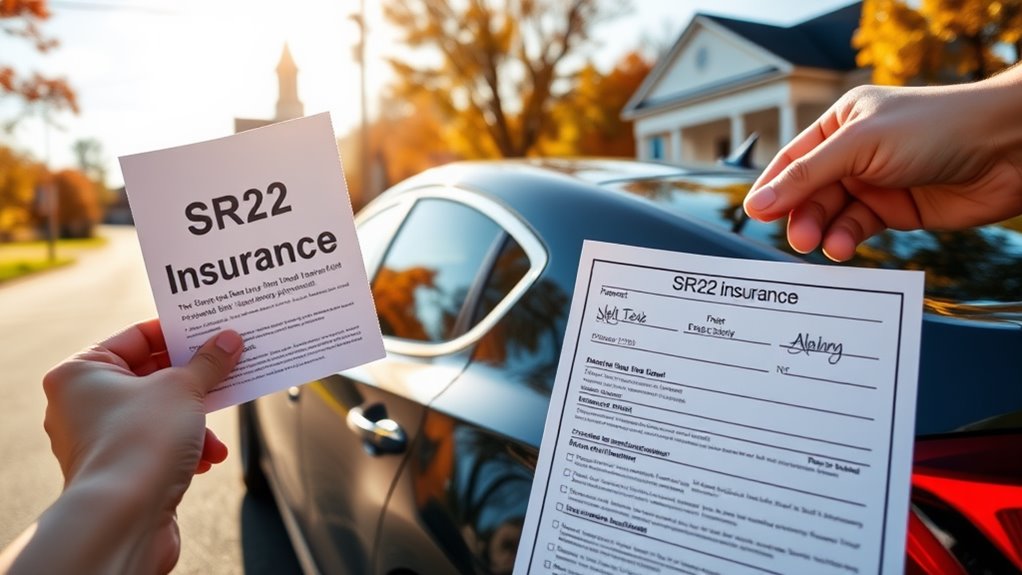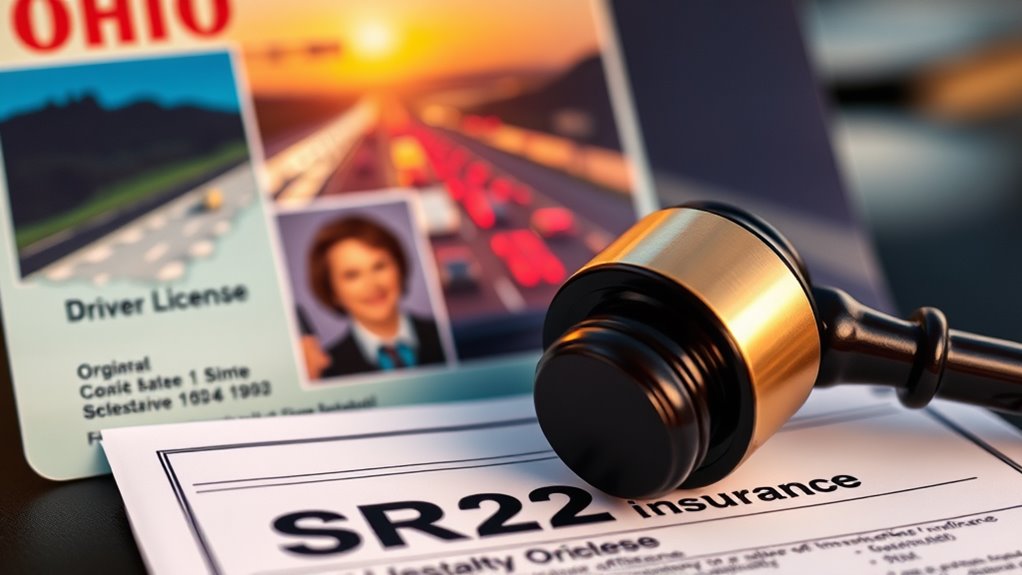Steering through the complexities of SR-22 insurance can feel like walking a tightrope, requiring balance between cost and coverage. Understanding the factors that influence your premiums is vital. From comparing quotes to exploring discounts, there are strategic ways to manage your expenses. However, many drivers overlook key elements that could lead to substantial savings. Let's explore these essential tips to guarantee you're making informed decisions about your SR-22 insurance costs.
Key Takeaways
- Shop around and obtain quotes from multiple providers to find competitive SR-22 insurance rates.
- Maintain a clean driving record post-SR-22 to help lower future premiums.
- Apply available discounts, such as bundling policies or completing defensive driving courses.
- Review your coverage needs regularly to avoid paying for unnecessary features.
- Inquire about filing fees and potential loyalty discounts with your insurance provider.
Understanding SR-22 Insurance Requirements in Ohio
When maneuvering the complexities of SR-22 insurance requirements in Ohio, it's crucial to understand that an SR-22 isn't an insurance policy itself but rather a certificate that verifies you hold the minimum required liability coverage.
Typically, high-risk drivers, due to serious traffic offenses like DUI or reckless driving, must obtain this certification. The Ohio Bureau of Motor Vehicles mandates that your SR-22 insurance includes at least $25,000 for bodily injury per person, $50,000 total bodily injury per accident, and $25,000 for property damage. Minimum liability coverage is essential to meet the state's requirements and avoid further penalties. Additionally, SR-22 insurance often leads to higher premiums due to the increased risk associated with the driver.
You'll need to maintain this coverage for three to five years, depending on your offense's severity. Your insurance provider will file the SR-22 form electronically with the BMV, streamlining the process for you.
Factors Affecting SR-22 Insurance Costs
Obtaining SR-22 insurance comes with varying costs influenced by several key factors. Your driving history plays a vital role; serious violations like DUIs lead to considerably higher premiums compared to minor infractions.
SR-22 insurance costs vary significantly based on your driving history and the severity of past violations.
Geographical location also impacts rates, with states like Michigan having average costs exceeding $8,300 annually, while Maine offers more affordable options around $1,331.
The type of vehicle you drive matters, too; safer vehicles can help reduce premiums. Additionally, the level of coverage you choose affects costs, with non-owner policies typically being cheaper.
Finally, maintaining a good credit score and ensuring timely payments can prevent rate increases, as insurers consider these factors when calculating your overall risk and insurance costs.
How to Compare Quotes for SR-22 Insurance
How can you effectively compare quotes for SR-22 insurance to confirm you're getting the best deal? Start by obtaining quotes from multiple companies, as rates can vary considerably.
Ascertain each quote reflects the same coverage levels for an accurate comparison. Evaluate the financial stability of the insurers using ratings from agencies like AM Best, which helps you gauge reliability.
Don't forget to assess customer service reputation through reviews, as quality support is crucial. Additionally, inquire about available discounts, such as for good drivers or bundling policies.
Finally, consider any filing fees associated with SR-22 insurance, as these can impact your total cost. A thorough approach will help you find the most affordable and reliable SR-22 insurance.
Exploring Non-Owner SR-22 Insurance Options
While managing the complexities of SR-22 insurance, you might find non-owner SR-22 options particularly beneficial if you don't own a vehicle but need to meet state insurance requirements.
This type of insurance is ideal for high-risk drivers or those with suspended licenses. Here are key points to reflect on:
- Liability Protection: Covers you when driving borrowed or rented vehicles.
- Compliance: Guarantees you meet state-mandated insurance requirements.
- Affordability: Generally less expensive than traditional policies.
- Flexibility: Suitable for those with limited vehicle access.
- Filing Process: Insurers typically handle the SR-22 filing, streamlining your experience.
Non-owner SR-22 insurance provides a practical solution for maintaining legal compliance without the need for vehicle ownership.
Cost-Saving Strategies for Ohio Drivers
Maneuvering the financial landscape of SR-22 insurance in Ohio can be intimidating, especially for those already facing higher premiums due to high-risk classifications.
To save on costs, start by shopping around for quotes from various providers, as rates can vary considerably. Utilize online platforms to compare multiple offers efficiently.
Consider applying available discounts, such as bundling policies or completing defensive driving courses. Additionally, review your coverage needs to make sure you're not overpaying for unnecessary features.
If possible, increase your deductibles to lower your premiums. Finally, stay informed about industry changes and maintain timely payments to avoid late fees, which can add unnecessary costs.
Implementing these strategies can help you manage your SR-22 insurance expenses effectively.
The Importance of Maintaining a Clean Driving Record
Maintaining a clean driving record is essential not only for personal safety but also for your professional opportunities and financial well-being.
Consider these vital aspects:
- Improved Job Prospects: Employers favor candidates with clean records, especially in driving-related roles.
- Lower Insurance Premiums: Insurers see you as a lower risk, which can lead to reduced rates.
- Enhanced Trust: A clean record fosters credibility with employers and insurers, indicating responsible habits.
- Regulatory Compliance: Industries like transportation require clean driving histories for safety standards.
- Economic Benefits: Companies benefit from hiring safe drivers, which can lead to better job opportunities for you.
Benefits of Bundling Insurance Policies
Bundling insurance policies can greatly enhance both your financial savings and administrative efficiency, making it a strategic choice for many consumers. By purchasing multiple policies from the same provider, you often benefit from multi-policy discounts, which can range from 5% to 25%.
This not only reduces your overall costs but also simplifies billing, as you'll deal with just one insurer. Handling claims becomes more efficient, especially when multiple assets are involved, and you'll have a single point of contact for inquiries.
Additionally, bundling can foster loyalty, potentially preventing policy cancellations. However, it's crucial to evaluate individual policies to verify that bundling provides the best overall value tailored to your needs, allowing for ideal insurance management.
How Defensive Driving Courses Can Lower Premiums
While many drivers seek ways to lower their insurance premiums, enrolling in a defensive driving course can be an effective strategy that not only enhances your driving skills but also leads to significant savings.
Here are some key benefits:
- Premium Reduction: Potentially reduce SR-22 premiums by 5% to 20%.
- Risk Assessment: Insurers view you as a lower risk after completing the course.
- Temporary Measure: SR-22 requirements are often short-term, making this a strategic option.
- Cost-Effectiveness: Course costs ($15 to $100) are typically offset by insurance savings.
- Certification Requirement: Completing an approved course is essential to qualify for discounts.
The Role of State Regulations in SR-22 Pricing
Understanding how state regulations impact SR-22 pricing is essential for drivers steering through the complexities of high-risk insurance. Each state has unique SR-22 requirements, including mandatory coverage periods and minimum liability limits, which can greatly influence costs.
For instance, while most states require an SR-22 for three years, some may extend this duration based on the offense. Additionally, filing fees vary, typically around $25 to $50, but some states impose extra penalties for violations.
The type of offense, such as DUI or reckless driving, directly affects premium rates due to perceived risk. Overall, managing these state-specific regulations is vital for finding affordable SR-22 insurance options tailored to your individual circumstances.
Tips for Managing SR-22 Insurance Payments
Managing SR-22 insurance payments can be an intimidating task, especially when you're maneuvering through the financial implications of high-risk coverage.
Navigating SR-22 insurance payments can be daunting, particularly with the challenges of high-risk coverage costs.
Here are some tips to help you manage these payments effectively:
- Compare Quotes: Always shop around to find the best rates from multiple insurers.
- Adjust Deductibles: Consider raising deductibles to lower your premiums, but be aware of potential out-of-pocket costs.
- Limit Drivers: Keep added drivers to a minimum, particularly those with poor driving records.
- Pay on Time: Guarantee timely premium payments to avoid late fees and rate increases.
- Utilize Discounts: Look for available discounts, such as for defensive driving courses or bundling policies.
Conclusion
Steering through SR-22 insurance costs can feel like traversing a maze, but with the right strategies, you can find your way to savings. By comparing quotes, leveraging discounts, and staying proactive with your policy, you can greatly reduce your expenses. Think of your insurance journey as a chess game—each calculated move can lead to a stronger position. Stay informed and diligent, and you'll emerge victorious in managing your SR-22 costs effectively.
















